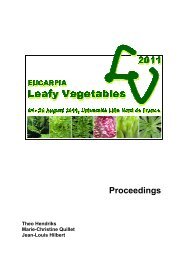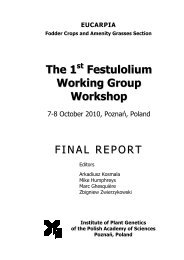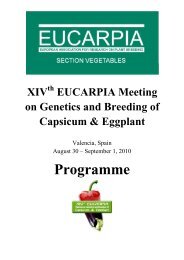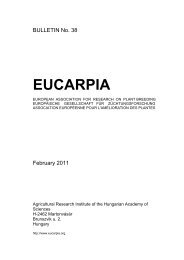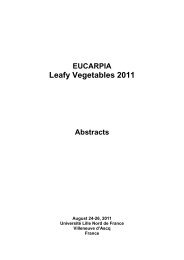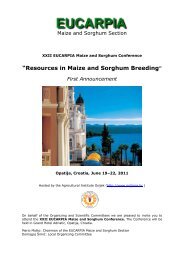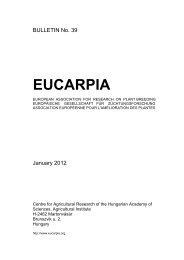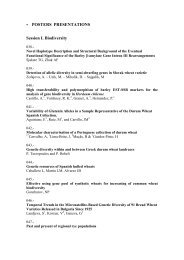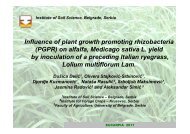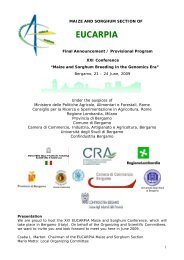Plant breeding for organic and sustainable, low-input agriculture
Plant breeding for organic and sustainable, low-input agriculture
Plant breeding for organic and sustainable, low-input agriculture
Create successful ePaper yourself
Turn your PDF publications into a flip-book with our unique Google optimized e-Paper software.
Genetic diversity of an emmer population grown under <strong>organic</strong> farming in Central Italy<br />
Renzo Torricelli, Mario Falcinelli<br />
<strong>Plant</strong> Biology, Agro-environmental <strong>and</strong> Animal Biotechnology Dept., University of Perugia,<br />
Italy<br />
Emmer (Triticum dicoccum Schubler, 2n= 4x= 28) is a predominantly self pollinated crop<br />
widespread throughout the Mediterranean Basin. The cultivation of this hulled wheat species has<br />
survived only in a few marginal mountainous areas of central <strong>and</strong> southern Italy. In central Italy<br />
the area cultivated with emmer increased during the last decade due to renewed interest in<br />
natural <strong>and</strong> healthy food <strong>and</strong> in <strong>organic</strong> <strong>agriculture</strong>. Since this species has not been bred with<br />
modern strategies, l<strong>and</strong>races are the only genetic material available. Hence the acreage of emmer<br />
has increased especially in marginal areas because it is well-suited to <strong>low</strong> <strong>input</strong> agronomic<br />
systems. Emmer l<strong>and</strong>races are still maintained <strong>and</strong> managed on-farm because of their resistance<br />
to harsh climatic conditions, cultural reasons, or organoleptic aspects which make them highly<br />
valuable. The objective of this study was to characterize the genetic structure of a central Italian<br />
l<strong>and</strong>race of emmer named “Monteleone di Spoleto”. 106 r<strong>and</strong>omly chosen spikes were collected<br />
from an <strong>organic</strong> field in Monteleone di Spoleto, 1000 m a.s.l. (Perugia – Italy). The physiological<br />
<strong>and</strong> morphological traits of progenies of each genotype were evaluated. The fol<strong>low</strong>ing<br />
characteristics were recorded: growth habit (GH), stem colour (SC), heading time (HT), plant<br />
height (PH), seed yield/plant (SY) <strong>and</strong> score of naked seed (SNS). Univariate <strong>and</strong> multivariate<br />
analysis showed wide genetic diversity within l<strong>and</strong>race of Monteleone di Spoleto emmer. The<br />
Principal Component Analysis (PCA) showed that the first three components accounted <strong>for</strong><br />
34.8%, 18.4% <strong>and</strong> 18.1% of variance, respectively (cumulative = 70%). On the basis of the<br />
eigenvector values, the traits responsible <strong>for</strong> maximum separation along the first component,<br />
were: heading time, plant height <strong>and</strong> seed yield/plant. The PCA has al<strong>low</strong>ed to group the 106<br />
lines of emmer in a restricted number of different families. These homozygous families differ<br />
one another <strong>for</strong> at least one trait. We concluded that the emmer “Monteleone di Spoleto” can be<br />
considered like a natural composite variety originated by continuous on farm conservation; it is<br />
genetically heterogeneous <strong>and</strong> is well adapted to the local environmental conditions.<br />
65




